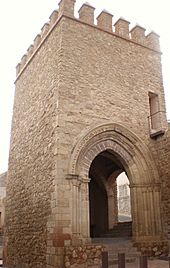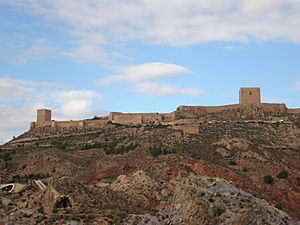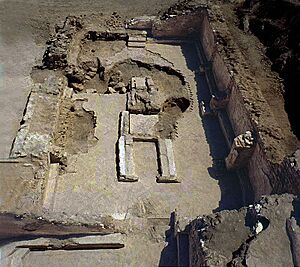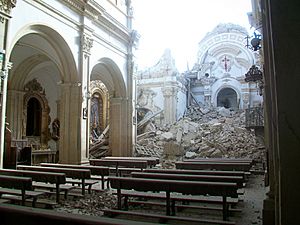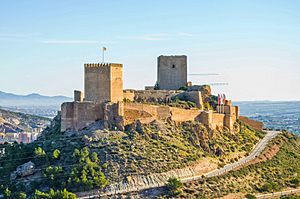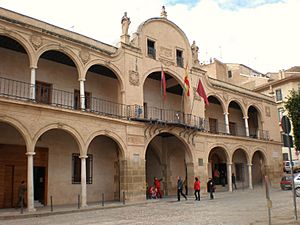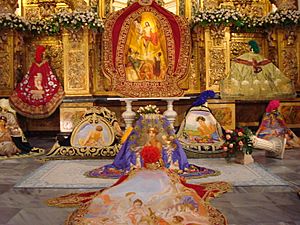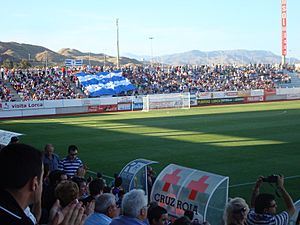Lorca, Spain facts for kids
Quick facts for kids
Lorca
|
|||
|---|---|---|---|
|
|||
| Motto(s):
Lorca solum gratum, castrum super astra locatum, ensis minans pravis, regni tutissima clavis
|
|||
| Country | Spain | ||
| Autonomous community | Region of Murcia | ||
| Province | Murcia | ||
| Comarca | Alto Guadalentín | ||
| Judicial district | Lorca | ||
| Area | |||
| • Total | 1,676 km2 (647 sq mi) | ||
| Elevation | 353 m (1,158 ft) | ||
| Population
(2018)
|
|||
| • Total | 93,079 | ||
| • Density | 55.536/km2 (143.84/sq mi) | ||
| Demonym(s) | Lorquino, lorquina | ||
| Time zone | UTC+1 (CET) | ||
| • Summer (DST) | UTC+2 (CEST) | ||
| Postal code |
30800
|
||
Lorca (Spanish: [ˈloɾka]) is a city and municipality in the Region of Murcia in southeastern Spain. It's about 36 kilometers southwest of the city of Murcia. In 2020, Lorca had a population of 95,515 people.
Lorca is known for having the second-largest land area among all municipalities in Spain, covering about 1675 square kilometers. The city is home to the impressive Lorca Castle and a special church called the Collegiate church of St. Patrick.
In the Middle Ages, Lorca was an important border city between Christian and Muslim lands. Long before that, during the Roman period, it was known as Ilura or Heliocroca.
On May 11, 2011, a strong earthquake with a magnitude of 5.1 hit Lorca. It caused serious damage and sadly, at least nine people lost their lives. Because the earthquake happened very close to the surface, it was much more destructive than other earthquakes of similar size.
Contents
Exploring Lorca's Past
Ancient Times and Early Settlements
Archaeologists have found evidence that people have lived in the Lorca area for a very long time, since the Stone Age, about 5,500 years ago. The first permanent settlements were in the Guadalentín River valley. This was probably because there was plenty of water, valuable minerals, and it was a good spot along a natural route to Andalusia.
Below the castle and the town, digs have uncovered important remains from the El Argar culture, which existed during the Bronze Age.
During the Roman period, there was a settlement here called Eliocroca. It was mentioned in old travel guides and was located right on the important Via Augusta road. Eliocroca was significant enough to have its own bishop, but this status was lost when Muslim rule began.
From Medieval Battles to Modern Growth
In 713, a peace agreement called the Teodomiro Pact was signed. It mentioned Lorca by the name "Lurqa." Under this pact, Lorca became part of an independent Christian state with six other cities, ruled by Theudimer. This arrangement lasted until his death.
Later, the Muslims reorganized the area, and Lorca became a part of Córdoba's territory. This led to the creation of smaller kingdoms called Taifas. The Taifa of Lorca was one of these, becoming independent in 1042. Its power reached as far as Jaén and Baza. During the Arab period, the city was known as Lurka, and its old town with narrow streets got its current shape under Moorish rule.
In 1244, Fernando III, the King of Castilla y León, and his son Prince Alfonso (who later became Alfonso X of Castile), conquered Lorca. The main tower of Lorca's fortress was named Torre Alfonsina in honor of the King.
Lorca was a dangerous border town in the late Middle Ages. It was a Christian outpost against the Moorish Emirate of Granada. Lorca was used as a base for attacks into enemy lands. The Battle of Los Alporchones happened here in 1452. The Kingdom of Murcia finally took Granada in 1492.
After the wars ended, Lorca began to change. The city started many building projects and trade grew. Many workers came to Lorca, and its population increased to 8,000 people. New buildings included the Colegiata de San Patricio, built in 1553, which became the city's main religious center. Many convents, like La Merced and Santo Domingo, were also built.
In the 17th century, Lorca became a more modern city, but it still had to defend itself from threats along the coast. This century also saw the expulsion of the Moors, a terrible plague that killed half the population, and long periods of drought. However, from 1660 onwards, the city began to recover and develop. The beautiful Palacio de Guevara, built in 1694, is a great example of baroque architecture from this time.
The 18th century was very important for Lorca. It became a truly modern city, losing its medieval look. The population grew, and new neighborhoods appeared. The old defensive wall was removed, showing that the times were safer. The city became a hub for artists like painters and sculptors.
On April 30, 1802, a disaster struck Lorca. The walls of a nearby reservoir broke, flooding the town and destroying many buildings. Up to 700 people died. In the 19th century, wars, epidemics, and droughts caused famine, leading over twelve thousand people to leave the region.
By 1845, Lorca was the largest and most populated municipality in Murcia. Trade declined at first, but new railways in the late 1800s helped connect the region to the rest of Spain. This allowed minerals and people to move more easily. This period also saw the construction of important buildings like the Teatro Guerra in 1861 and the Plaza de Toros (bullring) in 1892.
In the early 20th century, mining in the coastal area brought new life to the economy. After World War II, the population stopped growing due to people moving away. But today, that has changed. Industries like leather, pottery, cement, and meat processing make Lorca an important agricultural and industrial center.
On October 19, 1973, Lorca and Puerto Lumbreras suffered a terrible flood that took more than 50 lives.
In 2002, during archaeological digs at Lorca Castle, the old Judería, or Jewish neighborhood, was discovered. This included the Synagogue of Lorca, which was special because it was one of the few synagogues in Spain that was not turned into a church after the Jews were expelled. Items found during the excavation, like menorahs, can be seen at the Lorca Archeological Museum.
On January 29, 2005, a 4.6 magnitude earthquake hit Lorca, causing damage to buildings. This was a warning for what was to come.
The 2011 Earthquake
The town was severely damaged by a magnitude 5.3 earthquake on May 11, 2011. Sadly, at least nine people died.
The United States Geological Survey (USGS) reported that the larger earthquake had a preliminary magnitude of 5.3. It was so shallow, meaning it happened very close to the surface, that its impact felt like a much stronger earthquake. It struck 350 kilometers south-southeast of Madrid at 6:47 p.m. local time. The quake was only about 1 kilometer deep and was preceded by a smaller 4.5 magnitude quake in the same area.
Lorca Castle, a medieval fortress built between the 9th and 15th centuries, suffered serious damage to its walls and the Espolón Tower during this earthquake.
Lorca's Geography and Climate
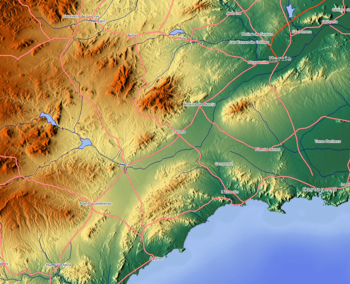
Lorca is located about 366 meters above sea level in eastern Spain, between Granada and Murcia. It was known for its fertile land and important location during the Muslim period. The city sits on the southern slopes of the Siera del Cano mountains, and the Guadalentín River flows through it.
The municipality of Lorca is very large, covering about 1676 square kilometers. It has a variety of landscapes, from the coastline to mountainous areas in the northwest and northeast. Lorca grew around the Guadalentín River (which means "mud river" in Arabic) in a dry valley. Farming in the area relies heavily on water brought from the Tagus river in Central Spain. The Moors built irrigation channels all over the region during the Middle Ages.
Lorca's Beaches
Lorca's municipality reaches the Mediterranean Sea, with about 8 kilometers of coastline. There are many beaches along this stretch, often surrounded by hills and coves with plants. Some popular beaches include:
- Calnegre: A peaceful sand beach, 1200 meters long and 20 meters wide, with calm waters.
- Cala Leña: Part of Blana Cove, with hills covered in plants and clear sea water.
- El Ciscar: A gravel beach surrounded by low hills.
- El Muerto: A beach with black volcanic sand and rocky areas.
- La Galera: A gravel beach with a cove and rocky cliffs covered by plants.
- Los Hierros: Another gravel beach.
- Larga: A 500-meter wide gravel beach.
- La Junquera: A small gravelly beach with rocky landforms.
Calnegre beach is considered one of the best beaches in Spain.
Lorca's Climate
Lorca has a cold desert climate (Köppen climate classification: BWk). This means it has mild winters and hot summers, with very little rain throughout the year. It is one of the driest cities in Spain and Europe, and one of the few places with a desert climate. In winter, temperatures sometimes drop below 0°C, while in summer, temperatures often go above 35°C, sometimes even reaching over 40°C.
| Climate data for Lorca (1991-2020), extremes (1955-present) | |||||||||||||
|---|---|---|---|---|---|---|---|---|---|---|---|---|---|
| Month | Jan | Feb | Mar | Apr | May | Jun | Jul | Aug | Sep | Oct | Nov | Dec | Year |
| Record high °C (°F) | 27.6 (81.7) |
29.0 (84.2) |
34.0 (93.2) |
36.4 (97.5) |
37.9 (100.2) |
41.9 (107.4) |
44.5 (112.1) |
45.0 (113.0) |
41.9 (107.4) |
34.1 (93.4) |
32.0 (89.6) |
29.3 (84.7) |
45.0 (113.0) |
| Mean daily maximum °C (°F) | 16.1 (61.0) |
17.3 (63.1) |
19.8 (67.6) |
22.3 (72.1) |
26.2 (79.2) |
30.8 (87.4) |
34.0 (93.2) |
34.0 (93.2) |
29.3 (84.7) |
24.8 (76.6) |
19.4 (66.9) |
16.8 (62.2) |
24.2 (75.6) |
| Daily mean °C (°F) | 10.0 (50.0) |
11.1 (52.0) |
13.4 (56.1) |
15.8 (60.4) |
19.6 (67.3) |
23.8 (74.8) |
26.7 (80.1) |
27.0 (80.6) |
23.1 (73.6) |
18.8 (65.8) |
13.7 (56.7) |
10.8 (51.4) |
17.8 (64.1) |
| Mean daily minimum °C (°F) | 3.9 (39.0) |
4.9 (40.8) |
7.0 (44.6) |
9.4 (48.9) |
12.9 (55.2) |
16.7 (62.1) |
19.4 (66.9) |
20.0 (68.0) |
16.8 (62.2) |
12.7 (54.9) |
7.8 (46.0) |
4.8 (40.6) |
11.4 (52.4) |
| Record low °C (°F) | −6.0 (21.2) |
−5.5 (22.1) |
−3.7 (25.3) |
−0.8 (30.6) |
1.6 (34.9) |
7.8 (46.0) |
9.3 (48.7) |
8.2 (46.8) |
5.8 (42.4) |
1.8 (35.2) |
−3.0 (26.6) |
−5.5 (22.1) |
−6.0 (21.2) |
| Average precipitation mm (inches) | 16.1 (0.63) |
15.8 (0.62) |
22.3 (0.88) |
21.7 (0.85) |
19.7 (0.78) |
11.9 (0.47) |
1.4 (0.06) |
8.9 (0.35) |
29.9 (1.18) |
24.3 (0.96) |
24.6 (0.97) |
19.8 (0.78) |
216.4 (8.53) |
| Source: Agencia Estatal de Meteorología (AEMET OpenData) | |||||||||||||
Famous Places to See
Lorca Castle
Lorca Castle stands high above the city, easy to spot from far away. It was built by the Moors between the 8th and 12th centuries. You can still see parts of the old water systems from that time within the castle. The Alfonsí Tower, a rectangular tower, and the Espolón Tower are part of the castle's defenses.
When Alfonso X recaptured the city in 1243, the Alfonsí Tower was added to strengthen the fort. Today, the castle is a popular spot for festivals and events. It has even been turned into a theme park with cool displays, actors in costumes, and special effects.
Plaza de España
The Plaza de España, or Spanish Square, is one of Lorca's most famous landmarks. It's right in the middle of the city's historic center. Around the plaza, you'll find important buildings like the Collegiate San Patricio, the Casa del Corregidor, and the Posito (a granary from the 16th century). These buildings were constructed between the 16th and 18th centuries. The Plaza has been recognized as a Cultural Monument.
Colegiata de San Patricio
The Collegiate Church of San Patricio is a beautiful Renaissance-style building located in the Plaza de España. It was named a National Historic-Artistic site in 1941. This church is unique because it's the only one in Spain dedicated to St. Patrick, the Irish saint. This dedication comes from the Battle of Los Alporchones, which was fought on March 17, 1452 (St. Patrick's Day) against people from Granada.
Construction of the church began in 1533, but it wasn't finished until 1704. The church has a detailed Baroque front and Renaissance-style interiors.
Museums in Lorca
Lorca has several museums. The Museo de Arqueologico Municipal, located in the Plaza de Juan Moreno, is very popular. There's also an embroidery museum where you can see amazing embroidered works. The city hall displays paintings of battles fought in and around Lorca, as well as art by local artists.
- Museo Arqueológico
Other Historic Sites
Lorca is full of old buildings and monuments, many built in the Baroque style. You can find Roman villas, palaces, and unique artworks.
In the city center, La Casa de Guevara is an old Baroque building from the 16th to 18th centuries, built by the Guevara family. Another historic place is the Iglesia de San Mateo, which has an impressive arched interior.
- A Roman Milepost from 10 BC, from the time of Emperor Augustus, is an important landmark. A statue of San Vincente was placed on top of it in the 15th century.
- Lorca City Hall, built in the 17th–18th centuries, was originally a prison.
- The medieval walls and the San Antonio gate (13th-early 14th centuries) were the main entrance to the city in Arabic times.
- The Santo Domingo complex (16th–18th centuries) includes a church, the Capilla del Rosario, and parts of a convent.
- Iglesia de San Francisco (Lorca) (1561–1735), also known as the temple of San Francisco, is a national monument. It was first built by the Franciscan Order in the mid-16th century and later rebuilt. It has many Baroque altar pieces.
- Palace of the counts of San Julián, a beautiful palace from the 17th century.
- Huerto Ruano Palace, a city villa from the 19th century.
- Casa del Corregidor, a house built in the 18th century.
- Pósito de los Panaderos, a granary built in the 16th century.
- Teatro Guerra is the oldest theater in the Murcia Region, opened in 1861.
- Plaza de Toros (1892), the bullring.
Lorca's Economy
Lorca's economy mainly relies on farming and raising animals, especially pigs and cows. It's also a commercial center for the surrounding area, with many service industries. The city exports a lot of pork products and textiles.
In recent years, Lorca's population has grown due to people moving there, mostly from Ecuador and Morocco.
The city is working to attract more businesses by setting aside land for industrial parks and research projects. The Lorca City Hall has approved plans to develop industrial areas and even a Health Sciences University Campus.
To boost tourism, the Region of Murcia, the City Council of Lorca, and local business groups have teamed up to promote Lorca's cultural tourism. They are focusing on preserving historic buildings and creating special tours to show off the city's rich history and culture.
Fun Cultural Activities
One of the most famous cultural events in Lorca is the Easter celebration, known as Semana Santa (Holy Week). This festival has been popular since 1855. It's famous for two brotherhoods, the Azul (blue) and Blanco (white), who compete to display amazing embroidered cloaks.
Each brotherhood carries an image of Virgin Mary – one with a blue cloak and the other with a white cloak, along with a banner and a museum. The music played during this event is unique, mixing stories from the Old Testament and the New Testament. Besides the annual festival, there are four small museums where you can see the beautiful Semana Santa costumes. These costumes are finely embroidered on silk and show historical and religious scenes. Some of these cloaks can be as long as 5 meters! Another festival, La Virgen de Las Huertas, is celebrated every year on September 8.
Education in Lorca
Lorca has many schools and learning centers:
|
|
|---|
Healthcare Services
The public health system in Lorca is managed by the Servicio Murciano de Salud (SMS). In February 2010, the Rafael Méndez Hospital became an accredited University General Hospital.
Hospitals
- Hospital General Universitario Rafael Méndez
- Hospital Virgen del Alcázar
Clinics
There are many primary care health centers located throughout the municipality:
- Consultorio La Torrecilla
- Consultorio Morata
- Consultorio Coy
- Consultorio Zarzadilla de Totana
- Consultorio Las Terreras
- Consultorio Tova-La Parroquia
- Consultorio Campillo
- Consultorio Escucha
- Consultorio Ramonete
- Consultorio Cazalla
- Consultorio Zarcilla de Ramos
- Consultorio Doña Inés
- Consultorio La Campana / Pozo Higuera
- Consultorio Aguaderas
- Consultorio Campo López
- Consultorio Avilés
- Consultorio La Hoya
- Consultorio Marchena
- Consultorio Puente La Pía
- Consultorio Purias
- Consultorio Tercia
- Consultorio Consejero
- Consultorio Almendricos
- Consultorio Torrecilla
Sports in Lorca
Sports Teams
- Athletics
- Atletismo Eliocroca: An athletics club that competes in various events like cross country, track, and marathons.
- Football (Soccer)
- Lorca FC: A football team currently playing in the Tercera División.
- CF Lorca Deportiva: A football team in Segunda División B.
- Unión Deportiva Zarcilla: A football team active in the Preferente Autonómica de la Región de Murcia.
- Rugby
- Club Rugby Lorca
- Futsal (Indoor Soccer)
- Ciudad de Lorca Fútbol Sala
- Basketball
- Indigo Química: A basketball team that plays in the Primera Autonómica.
- Handball
- Club Balonmano Lorca: A team that plays in the Segunda División Nacional Masculina y Femenina.
- Asociación Deportiva Eliocroca: A team that plays in Segunda División Nacional.
- Volleyball
- Asociación Deportiva Eliocroca: A team that plays in the Liga FEV.
- Swimming
- Club Natación Lorca
Sports Venues
- Estadio Francisco Artés Carrasco
- Complejo deportivo Europa
- Ciudad deportiva de La Torrecilla
- Pabellón municipal de San José
- Pabellón municipal San Antonio
- Pabellón municipal de Almendricos
- Pabellón municipal de Las Alamedas
Famous People from Lorca
- Joaquín Arderíus
- José Luis Munuera (born 1972), comics artist
- Juan de Toledo, architect
- Juan Zurano (born 1948), retired professional cyclist
- Narciso Yepes, guitarist
- Rafael Maroto (1783–1853), military general
- Ramiro de Lorca (1452–1502), a military leader
See also
 In Spanish: Lorca para niños
In Spanish: Lorca para niños




